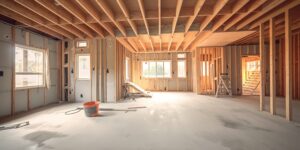Is another home building bubble ready to burst? Are record-setting home prices primed for a steep decline? Is demand still outpacing supply or have conditions changed?
The building outlook for the remainder of 2022 and start of 2023 is sending some mixed signals. New home starts and prices posted slight decreases in recent months, but Freddie Mac reports a shortage of about 3 million homes in the United States currently. Read the news and headlines using words like “cooling,” “tumbling,” and “signs of a fall” describe recent home construction trends. Mortgage rates are going up, yet home sales are still extraordinarily strong. Like we said—mixed signals—that have builders asking one question above all others: what do we do next?
Changing market conditions pose a risk for any business owner, but especially builders who make a high-stakes wager each time they break ground on a new project. With elevated upfront costs, significant supply chain delays, and slimming profit margins, most builders can’t afford to be blindsided by a sudden shift in the housing market. That is why the most successful home builders constantly evaluate market risks and adjust their strategic goals accordingly.
A shifting market poses one of the most volatile and potentially devastating risks for a home builder. Time it right and the business may achieve record-breaking profits. Predict things incorrectly and the costs can be catastrophic.
Luckily, home building need not be a guessing game. Builders can make strategic moves positioned to generate a good return on investment by following these three steps for evaluating market risks.
1. Monitor Market Conditions
Rising interest rates, shifting demand, elevated prices, inflation at a 40-year high, and the status of the current housing cycle—these are just a few of the constantly changing factors that impact builders. Performing a detailed market analysis is an important step in any construction project. Yet when it comes to home builder risk management, a one-time analysis is not enough. Builders must consistently monitor market conditions to stay ahead of a changing risk landscape.
That means tracking key market and economic indicators such as:
- Interest rates – Today’s housing prices have many would-be buyers sitting out of the market. Increases to mortgage rates will drive other shoppers out of the market as well. The Federal Reserve sends out warning signals before it makes an interest rate move. Current projections show small hikes occurring across the next several quarters.
- New home permits and sales – Total U.S. home permits issued and home sales is a less important indicator than data by geographic area. Follow the trends for places of development interest. For example, while April and May posted slight declines, hot markets exist around the country where demand significantly outweighs supply—a home builder’s ideal scenario. Macro trends may cover up micro-opportunities for builders focused on the wrong information.
- Price indices – Home prices differ geographically as well. The pandemic created a migration of people leaving big cities and moving to the suburbs. Overall home price decreases do indicate an economic recession that may slow construction. However, a better tool for builders is reviewing home prices by zip code to find current and future growing markets for investment.
- NAHB’s Housing Market Index – HMI is based on a monthly survey of NAHB members that takes the pulse of the single-family housing market based on a rating of current market conditions. On a scale of zero to 100, the higher the score, the more positive the outlook. May’s preliminary national score sits at 69, an eight-point decline from April. However, the regional HMI score for the Northeast, South, and West regions show higher scores in the mid-70s.
Evaluating the market locally and nationally by monitoring interest rates and other economic trends can help determine when to build and the right number of homes.
2. Create a Risk Evaluation Table
When monitoring the housing market for potential issues, you need a mechanism for evaluating and prioritizing risks as they arise. You can calculate your risk level using a simple formula:
Risk Level = Likelihood X Impact
First you need to assign a numerical value to both the likelihood that the risk will occur and how severely it would impact your company. For example:
Likelihood
- Very likely (4): Occurs more than once a year
- Likely (3): Occurs about once a year
- Unlikely (2): Occurs every 10 years or
- Very unlikely (1): Has only occurred once
Impact
- Severe (4): Financial losses greater than $50,000
- High (3): Financial losses between $10,000 and $50,000
- Moderate (2): Financial losses between $1,000 and $10,000
- Low (1): Financial losses less than $1,000
These are sample numbers. Replace them with values that align with your company’s business. As you evaluate each risk, plug the scores into the formula for an overall risk rating. A risk with a high score requires immediate corrective action. A low rating requires limited or deprioritized action. This can be a powerful quantitative tool to help guide strategic decision-making.
3. Conduct Regular Risk Evaluation Meetings
A study on construction risk management found that nine in 10 builders cited increased collaboration as the key to mitigating future risks. The report found a distinct link between regular team meetings and formal brainstorming with improved project outcomes. The benefits include increased reliability in overall project performance, reduced construction costs, improved project scheduling, and better safety.
“The most effective risk evaluation strategies, according to the study, are regular meetings with the full project team focused on risk and the development of a plan to manage risk,” reports Dodge Data & Analytics, which conducted the study. “Both practices help increase project performance reliability, maintain project quality and improve project safety.”
Because housing markets can be volatile and construction risks are a constantly moving target, regular meetings help your team keep a finger on the pulse of changes in market conditions that could affect your company’s risk level. Bringing a variety of voices and perspectives to the table offers the added benefit of allowing you to draw upon multiple areas of expertise when evaluating your company’s risk landscape.
One form of collaboration that can make a significant difference in risk evaluation and management is a partnership with a third-party home builder warranty provider. By mitigating risks associated with construction defects while improving home builder reputation management through expert handling of homeowner complaints, a builder home warranty company such as PWSC can alleviate a large portion of a company’s risk management needs. That frees builders up to focus on other important factors—like evaluating ever-changing market risks and where to start the next home.




